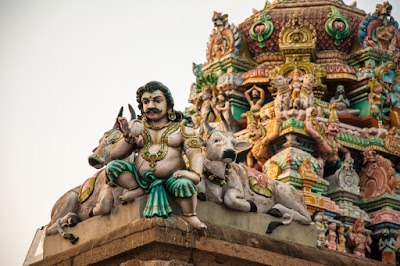 |
| Lord Kapaleeswara |
 |
| Goddess Karpagambal |
Sri Kapaleeswara temple is one of the oldest temples in
Mylapur which has got rich historical and cultural heritage. The 125 feet –tall
painted temple tower and colorful statues with intricate sculptural art fill
our hearts with a sense of wonder.
Mylapur is a very primitive coastal town dating back to first century.
Ptolemy (A.D.90—168) , a Greek geographer referred to this town in his book as
“Millarpha”. Tiruvalluvar, the poet-saint, who wrote “Tirukkural” was born here
in 4th century A.D. Great Saivite saints
of 7th century like Sambandar and Appar sang about this temple in
their hymns.
This place is regarded as another “Kailasapuri” where many gods
and saints
worshipped the Lord and got salvation. Previously this place was
called “Sukrapuri” and “Vedapuri’ where Sukracharya worshipped the Lord and got
back his lost eye. Brahma’s fifth head was cut off by Lord Shiva when he became
arrogant and thought himself as the supreme master of the whole universe. Later
Brahma realized his mistake and did penance here after installing a Shiva
lingam. He called the Lord as Kapaleeswara
and got back his power to create. In olden times Kapalikas, a sect of
Saivite monks, lived here and in Thiruvottiyur. Hence the Lord might have been
named as Kapaleeswara. Lord Rama worshipped the Lord here after he killed Ravana
in the battle. Four Vedas came and worshipped the Lord here. Goddess Parvati
was once cursed to become a pea-cock and she got liberated from the curse after
worshipping the Lord. Along with the Lord she stayed here as Karpagambal (one
who gives fulfills desires of devotees like wish-fulfilling tree). Lord Murugan
received the spear (Shakti Vel) from Parvati here. This place was named as
Mylapur as Parvati in the form of a Mayil (In Tamil it means a pea-cock)
worshipped the Lord here. On the northern wall of the prakaram in the courtyard, there is a small shrine
adjacent to a punnai tree, showing Karpagavalli worshipping Lord in the form of
a pea-cock.
Originally this temple was built by Pallava kings in 7th
century at the spot where now San Thom cathedral (St.Thomas Cathedral Basilica)
is seen. When the Portugese controlled this area (1522 to 1697), the temple was
demolished in 1561. The present structure of the temple was constructed by
Vijayanagara rulers of Tuluva dynasty (1491—1570). The structures of the old
temple might have been used here since old inscriptions dating back to 12th
century are seen on the walls of the new temple. The 125-foot tall east facing
gopuram was built later in 1906. The San Thom cathedral was built by Portugese in 16th century over the tomb of
St. Thomas and later was rebuilt in 1893 by the British. But as per evidence,the
actual body of St.Thomas was interred at Ortona Basilica in Italy. Besides
St.Thomas who came to India in 4th century from Iran was the
St.Thomas of Cana and not the apostle of St. Thomas as many believed.
This temple has two
entrances. The shrine of Narthana Vinayaka
is seen in front of the 125-feet tall eastern Raja Gopuram. As one enters the hall, the shrine of Karpagambal
is seen on one side facing south. A stone lion is found outside in front of
this shrine. The shrine of Kapaleeswara
is seen facing west (Sadyojatha form of Shiva). On the northern wall of the
main sanctum a small shrine of Durga is seen. On the back wall a small shrine
of Lingodbhava Moorty is seen. Just in front
of this the 63 images of Nayanmars are found. On the southern wall the shrine
of Dakshinamurty is seen. In the halls
of pillared mandapas there are shrines for Sundereswara, Jagadeeswara,
Annamalaiar and Unnamalai. There is a beautiful shrine of Murugan (called
Singarvelan) along with Valli and Devasena.
The smaller western gopuram faces the temple tank and is
surrounded on four sides by broad mada veedhis (streets). This temple tank was built by mayili
Muthaiappa Mudaliar in 16th century.The shrine of Saneeswara is seen
on the eastern prakaram. The platform with Navagrahas is of recent origin.
This temple is open
from 6.00 a.m. to 10.00 a.m. in the morning and from 5.30 p.m. to 10.00 p.m. in
the evening. In this temple special poojas are performed on Monday, New Moon
and Full Moon days. On Fridays special poojas are done in the shrine of
Karpagavalli. Every day poojas are performed six times (6.00 a.m. 9.00 a.m.
1.00 p.m 5.00 p.m. 7.00 p.m. amd 9.00 p.m.)
There are four yearly festivals. Rahu Abhishekam is performed twice at
11.30 a.m. and 5.30 p.m. every day and two more times on designated days and timings.
The Arupathimoovar festival is grandly
celebrated for ten days in March-April. The deities are taken in procession on
different vahanas or mounts. On the eighth day the sixty-three Nayanmar idols
follow the Kapaleeswarar idol in procession.
The nearby places of visit are Marina
Beach (1.7 kms), San Thomas cathedral (1km),Mundakaneeyaman temple (1km), Audi
Kesava Perumal Peyalvar temple (1km) and Rama Krishna temple (1.3 kms). One
should see this beautiful and spacious temple to get some idea about the
marvelous art of Dravidian sculpture. You will also find many shops selling
various types of Pooja material and refreshments by the way side.
***********************************************
17th August, 2018 Somaseshu Gutala





























